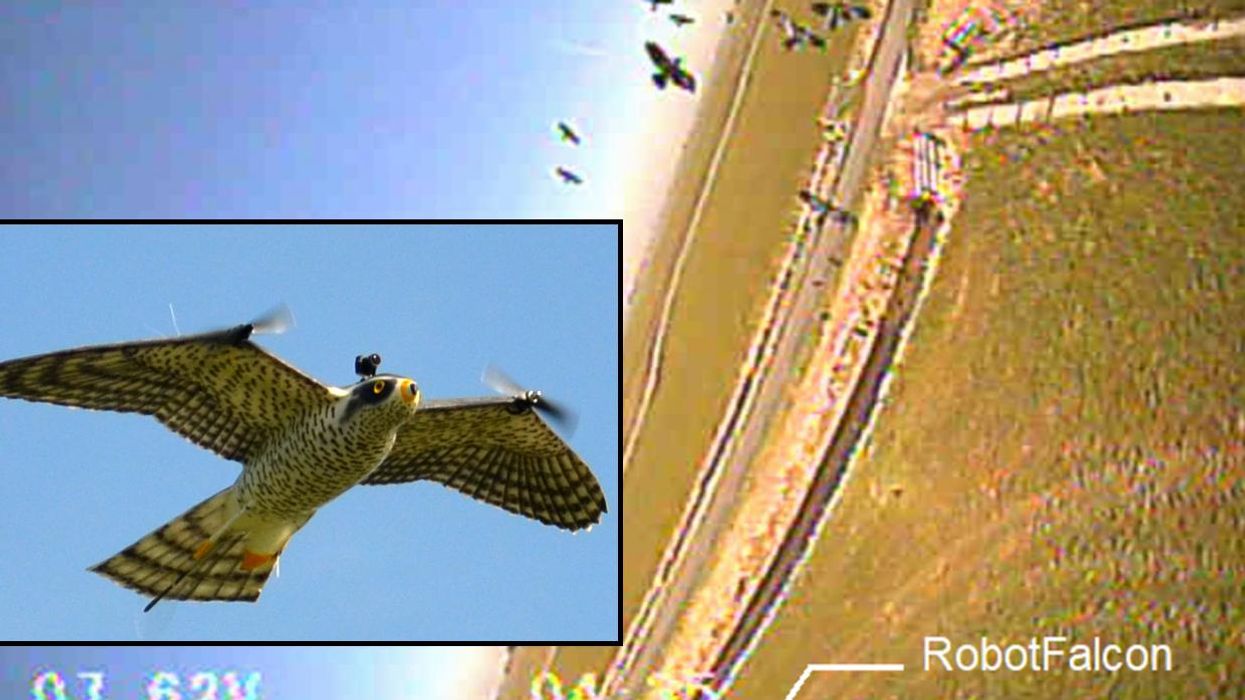
Collisions with birds are a serious problem for commercial aircraft, costing the industry billions of dollars and killing thousands of animals every year. New research shows that a robotic imitation of a peregrine falcon could be an effective way to keep them out of flight paths.
Worldwide, so-called “birdstrikes” are estimated to cost the civil aviation industry almost $1.4 billion annually. Devoting significant resources to dealing with the challenge, she says, for many means hiring full-time bird control experts. Nearby habitats are often deliberately made unattractive to birds, but airports also rely on a variety of deterrents designed to scare them away such as loud pyrotechnics or speakers that play distress calls from common species.
These approaches tend to get less effective over time though, says Charlotte Hemelrijk—a professor on the faculty of science and engineering at the University of Groningen—as the birds get desensitized by repeated exposure. Live hawks or blinding lasers are also sometimes used to disperse flocks, she says, but this is controversial as it can harm the animals, and keeping and training falcons is not cheap.
“The birds don’t distinguish [RobotFalcon] from a real falcon, it seems.”
—Charlotte Hemelrijk, University of Groningen
In an effort to find a more practical and lasting solution, Hemelrijk and colleagues designed a robotic peregrine falcon that can be used to chase flocks away from airports. The device is the same size and shape as a real hawk, and its fiberglass and carbon fiber body has been painted to mimic the markings of its real-life counterpart.
Rather than flapping like a bird, the “RobotFalcon” relies on two small battery-powered propellers on its wings, which allows it to travel at around 30 miles per hour for up to 15 minutes at a time. A human operator controls the machine remotely from a hawk’s-eye perspective via a camera perched above the robot’s head.
To see how effective the RobotFalcon was at scaring away birds, the researchers tested it against a conventional quadcopter drone over three months of field testing close to the Dutch city of Workum. They also compared their results to 15 years of data collected by the Royal Netherlands Air Force assessing the effectiveness of conventional deterrence methods such as pyrotechnics and distress calls.
Flock-herding Falcon Drone Patrols Airport Flight Paths
youtu.be
In a paper published in the Journal of the Royal Society Interface, the team showed that the RobotFalcon cleared fields of birds faster and more effectively than the drone. It also kept birds away from fields longer than distress calls, the most effective of the conventional approaches.
There was no evidence of birds getting habituated to the RobotFalcon over three months of testing, says Hemelrijk, and the researchers also found that birds exhibited behavior patterns associated with escaping from predators much more frequently with the robot than with the drone. “The way of reacting to the RobotFalcon is very similar to the real falcon,” says Hemelrijk. “The birds don’t distinguish it from a real falcon, it seems.”
Other attempts to use hawk-imitating robots to disperse birds have had less promising results though. Morgan Drabik-Hamshare, a research wildlife biologist at the DoA, and her colleagues published a paper in Scientific Reports last year where they pitted a robotic peregrine falcon with flapping wings against a quadcopter and a fixed-wing remote control aircraft.
They found the robotic falcon was the least effective of the three at scaring away turkey vultures, with the quadcopter scaring the most birds off and the remote-control plane eliciting the quickest response. “Despite the predator silhouette, the vultures did not perceive the predator UAS [unmanned aircraft systems] as a threat,” Drabik-Hamshare wrote in an email.
Zihao Wang, an associate lecturer at The University of Sydney in Australia who develops UAS for bird deterrence, says the RobotFalcon does seem to be effective at dispersing flocks. But he points out that its wingspan is nearly twice the diagonal length of the quadcopter it was compared against, which means it creates a much larger silhouette when viewed from the birds’ perspective. This means the birds could be reacting more to its size than its shape, and he would like to see the RobotFalcon compared to a similar sized drone in the future.
The unique design also means it requires an experienced and specially trained operator, Wang adds, which could make it difficult to roll out widely. A potential solution could be to make the system autonomous, he says, but it’s unclear how easy this would be.
Hemelrijk says automating the RobotFalcon is probably not feasible, both due to strict regulations around the use of autonomous drones near airports as well as the sheer technical complexity. Their current operator is a falconer with significant experience in how hawks target their prey, she says, and creating an autonomous system that could recognize and target bird flocks in a similar way would be highly challenging.
But while the need for skilled operators is a limitation, Hemelrijk points out that most airports already have full-time staff dedicated to bird deterrence who could be trained up. And given the apparent lack of habituation and the ability to chase birds in a specific direction—so they head away from runways—she thinks it could be a useful addition to their arsenal.
Source: IEEE Spectrum Robotics
